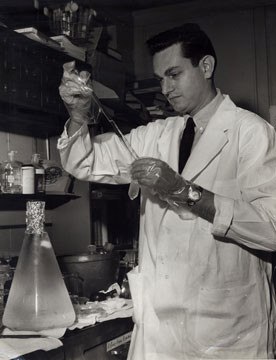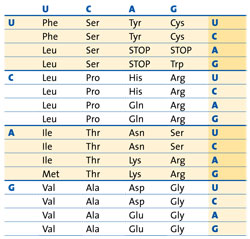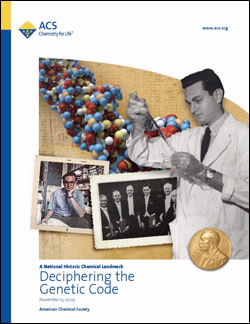Deciphering the Genetic Code
Dedicated November 12, 2009, at the National Institutes of Health in Bethesda, Maryland.
DNA consists of a code language comprising four letters which make up what are known as codons, or words, each three letters long. Interpreting the language of the genetic code was the work of Marshall Nirenberg and his colleagues at the National Institutes of Health. Their careful work, conducted in the 1960s, paved the way for interpreting the sequences of the entire human genome.
Contents
Modern Genetics: A Monk and a Double Helix
Modern genetics begins with an obscure Augustinian monk studying the inheritance of various traits in pea plants. Gregor Mendel’s laws of inheritance revealed the probabilities of dominant and recessive traits being passed from generation to generation. Mendel’s research received little recognition in his lifetime. The significance of Mendel’s laws was recognized only in the early 20th century.
With that rediscovery came interest in how genetic information is transmitted. Oswald Avery, a bacteriologist at New York’s Rockefeller Institute, demonstrated that deoxyribonucleic acid, DNA, produced inheritable changes. This discovery was not well received: How could DNA, a substance containing only four different nucleotide building blocks, store genetic information? Others discovered that DNA varies from species to species. Then, in 1953, James Watson and Francis Crick at Cambridge University electrified the scientific world with their model of DNA, the double helix. Watson and Crick recognized that the double strand might allow replication.
How could DNA, a double helix made up of only four different nucleotides, determine the composition of enzymes (proteins), long peptide chains composed of twenty different amino acids? The race to discover the genetic code which translates DNA’s information into proteins was underway. To stimulate the chase, George Gamow, a theoretical physicist, organized the twenty-member “RNA Tie Club”: members wore ties with the symbol for one of the 20 amino acids. The members shared ideas on how DNA transmitted information.
The scientist who won the race was not a member of the “club.”
I thought if I’m going to work this hard, I might just as well have fun and by fun I mean I wanted to explore an important problem and I wanted to discover things.”
— Interview with Marshall Nirenberg, July 15, 2009.
Marshall Nirenberg’s Early Career
Marshall Nirenberg earned a Ph.D. in biological chemistry from the University of Michigan with a dissertation on the mechanism of sugar uptake in tumor cells. He continued that research as a postdoctoral fellow at the National Institutes of Health. In 1959, he joined the staff of NIH as a research biochemist.
Nirenberg gave some thought to what he wanted to study as an independent investigator. “At that time,” he said in 2009, “the mechanism of protein synthesis was very incompletely known and messenger RNA had not been discovered.”*
Nirenberg’s initial goal was to determine whether DNA or RNA (ribonucleic acid), copied from DNA, was the template for protein synthesis. But Nirenberg had no formal training in molecular genetics, and he knew “that this was an incredibly risky project, because when you take your first position, you want to hit the deck running and show you are a productive scientist.” With no experience in the field, with no staff at the outset, and in a race against the best scientists, Nirenberg knew he “could fail easily.”
*This and subsequent quotations, unless the text indicates differently, are from an interview by Judah Ginsberg and Marshall Nirenberg, conducted in his laboratory on the campus of NIH on July 15, 2009.
Experiments with Synthetic RNA
Nirenberg and Heinrich Matthaei, a postdoctoral fellow from Germany, began their experiments by studying the long linear molecule DNA and RNA. In DNA, the nucleotides are adenine (A), guanine (G), cytosine (C) and thymine (T); in RNA, uracil (U), replaces thymine.
They chose a cell-free environment, created when cell walls are broken down, releasing the cell’s contents. The remaining cytoplasm can still synthesize protein when RNA is added, allowing the researchers to design experiments to determine how RNA works free of the complicated biological processes that could shroud molecular activity.
Nirenberg and Matthaei selected E. coli bacteria cells as their source of cytoplasm. They added the E. coli extract to 20 test tubes, each containing a mixture of all 20 amino acids. In each test tube one amino acid was radioactively tagged, a different one in each test tube. The reaction could be followed by monitoring radioactivity: incorporation of a “hot” amino acid would form a “hot” protein.
Breaking the Genetic Code: The “poly-U” Experiment
3:00 in the morning, May 27, 1961, a Saturday: Matthaei adds synthetic RNA made of only uracil units to each of the 20 test tubes, finding unusual activity in one of the tubes, containing phenylalanine. The spectacular result demonstrates that a chain of uracil units in the “hot” tube instructed the addition of the “hot” amino acid.
Nirenberg and Matthaei understood what had happened: Synthetic RNA made of a chain of multiple units of uracil instructed a chain of amino acids to add phenylalanine. The uracil chain (poly-U) served as a messenger directing protein synthesis. Although the question of how many units of U were required was yet unanswered, the experiment proved that messenger RNA transcribes genetic information from DNA, directing the assembly of amino acids into complex proteins. The key to breaking the genetic code—molecular biology’s Rosetta Stone—had been discovered.
Nirenberg presented his successful poly-U experiment at an international biochemistry congress held in Moscow in August, a few months later. He was acutely aware of his outsider status: “I didn’t know the people in molecular biology… I didn’t know anybody in protein synthesis… I was working on my own.” That may explain why only 35 people attended his talk and why the audience “was absolutely dead.”
But in one of those serendipitous events that change everything, Nirenberg had met Watson the day before and told the co-discoverer of the double helix about his results. Watson was skeptical about Nirenberg’s claims, but he convinced a colleague to attend the paper; when the colleague reported that Nirenberg’s findings were real, Watson told Crick who arranged for Nirenberg to present his paper again, this time in a major symposium on nucleic acids at the same congress. “The reaction was incredible,” Nirenberg remembered. “It was a standing ovation… I didn’t know it then, but for the next five years I became like a scientific rock star.”

After Nirenberg and Matthaei “cracked” the first “word” of the genetic code, scientists raced to translate the unique code words for each amino acid in hopes of someday reading the entire genetic code of living organisms. Nirenberg assembled a team of about twenty researchers and technicians.
Using the poly-U experiment as a model, Nirenberg and his colleagues identified nucleotide combinations for the incorporation of other amino acids. The researchers found that the coding units for amino acids contain three nucleotides (a triplet). Combining four nucleotides in three-letter codes yielded 64 possible combinations (4 x 4 x 4), sufficient to describe 20 amino acids.
They discovered the codes for other amino acids: for example, AAA for lysine and CCC for proline. Replacing one unit of a triplet code with another nucleotide yielded a different amino acid, for one example, synthetic RNA containing one unit of guanine and two of uracil (code word: GUU) caused incorporation of valine.
In 1964 Nirenberg and Philip Leder, a postdoctoral fellow at NIH, discovered a way to determine the sequence of the letters in each triplet word for amino acids. By 1966 Nirenberg had deciphered the 64 RNA three-letter code words (codons) for all 20 amino acids. The language of DNA was now understood and the code could be expressed in a chart.
The Nobel Prize and Reactions
In 1968 Nirenberg won the Nobel Prize in Physiology or Medicine for his seminal work on the genetic code. He shared the award with Har Gobind Khorana (University of Wisconsin), who mastered the synthesis of nucleic acids, and Robert Holley (Cornell University), who discovered the chemical structure of transfer-RNA. Collectively, the three were recognized “for their interpretation of the genetic code and its function in protein synthesis."
Nirenberg describes the ceremonies surrounding the Nobel as “a week of parties.” Not quite all parties, however, since the rules of the Nobel require recipients to write a review article. This proved a challenge for Nirenberg, who had turned his research attention to neurobiology. ”I found it very difficult,” he later admitted, “to break off from neurobiology and go back to nucleic acids.”
As a Nobel Laureate, Nirenberg received many university offers that included higher salary, more laboratory space, and larger staff. He turned them all down, preferring to spend the rest of his career at NIH. “The reason I stayed,” he says, “was because the thing I had least of was time. I figured that if I went to a university I would use a third of my time to write grants… I thought I could use that time more productively by doing experiments.”
In 1961 The New York Times, echoing President Kennedy, reported that Nirenberg’s research showed that biology “has reached a new frontier.” One journalist suggested the biggest news story of the year was not Russian cosmonaut Yuri Gagarin orbiting the earth but the cracking of the genetic code.
Deciphering the genetic code raised ethical concerns about the potential for genetic engineering. Nirenberg addressed these concerns in a famous editorial in Science in August 1967, noting “that man may be able to program his own cells” before “he has sufficient wisdom to use this knowledge for the benefit of mankind… [D]ecisions concerning the application of this knowledge must be made by society, and only an informed society can make such decisions wisely.” When asked several decades later if society has acted “wisely” regarding genetic engineering, Nirenberg answered, “Absolutely!”
Further Reading
- Marshall W. Nirenberg Biographical (NobelPrize.org)
- The Marshall W. Nirenberg Papers (The National Institutes of Health)
Landmark Designation and Acknowledgments
Landmark Designation
The American Chemical Society designated the deciphering of the genetic code by Marshall Nirenberg as a National Historic Chemical Landmark at the National Institutes of Health in Bethesda, Maryland, on November 12, 2009. The plaque commemorating the research reads:
In this building, Marshall Nirenberg and Heinrich Matthaei discovered the key to breaking the genetic code when they conducted an experiment using a synthetic RNA chain of multiple units of uracil to instruct a chain of amino acids to add phenylalanine. The uracil (poly-U) served as a messenger directing protein synthesis. This experiment demonstrated that messenger RNA transcribes genetic information from DNA, regulating the assembly of amino acids into complex proteins. Nirenberg would go on to decipher the code by demonstrating the correspondence of various trinucleotides to individual amino acids. He was a co-winner of the Nobel Prize in 1968.
Acknowledgments
Adapted for the internet from “Deciphering the Genetic Code,” produced by the National Historic Chemical Landmarks program of the American Chemical Society in 2009.
Back to National Historic Chemical Landmarks Main Page.
Learn more: About the Landmarks Program.
Take action: Nominate a Landmark and Contact the NHCL Coordinator.



